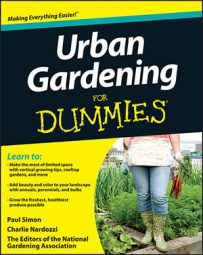Before you get started sowing seeds or planting transplants in your urban garden, it’s good to understand about frost dates and how they affect when you plant your seeds or seedlings indoors or outside. To keep track of the process, create a seed-starting schedule.
You can begin planning your seed-starting schedule in the winter months or early spring season. Though this may seem early to be thinking about starting seeds, planning ahead is essential if you want to grow plants that need quite a bit of time under lights or a head start before being transplanted into the garden.
To plan your schedule for starting seeds early indoors or planting other seeds directly into your urban garden, start by making a list of everything you want to plant. Then follow these steps:
Determine your region’s frost-free date.
Find the average frost-free date for your area. If you haven’t been keeping your own records, contact your county extension office or go to Average First and Last Frost Dates for US.
Plant after any chance of frost.
Planting after the chance of frost (any temperature below 32 degrees F) is the main goal, but if you’re looking to plant early, you can use different techniques to temporarily cover plants, retain additional heat, and keep out the cold to extend the planting season.
Develop a planting schedule for each transplant; in other words, determine the set-out dates.
Check the seed packet or catalog for this information, or check out a gardening book or the Internet. These sources usually list each vegetable along with the number of weeks before or after the last frost the plant can be set out.
Develop a seeding schedule.
After you know the set-out dates for the plants you want to grow, you need to figure out how far ahead of this date you should start your seeds if that’s appropriate for that type of vegetable. You can usually find this information on the seed packet, but if it’s not there, check the web.
The packet may tell you how many weeks from seeding to set-out, or it may tell you how many weeks from germination to set-out. If the latter is the case, you also have to look at the seed packet to find out how long the seeds take to germinate and figure this time period into your schedule.
Some are quick, while others, like parsley, may take two weeks or more just to germinate. Make sure you plan for this extra time when figuring out your schedule.
Record dates on your planting calendar.
Write the set-out date for each vegetable on a calendar. Then move backward through the weeks and record the seeding date. After you have all the set-out and seeding dates listed, go through the vegetables that you’ll seed directly outdoors and do the same thing. Hang your new planting calendar somewhere prominent where you’ll see it every day.
Your planting calendar is a very useful tool year to year because it helps provide a record of all your gardening activities, including when to start seeds indoors, when your frost-free dates were in the past, and when to transplant various plants outdoors. It gives you a recorded time line of what you did the year before so you can easily make adjustments the following year if you need to.

